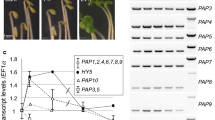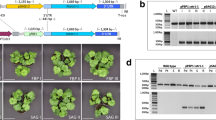Abstract
Significant similarities are now known to exist between bacterial celldivision and the division of plastids in higher plants. This is primarily duetothe recently proven requirement of homologues of the bacterial cell divisiongene ftsZ, for plastid division. This report describes thegeneration of three partial FtsZ cDNAs from cucumber byreverse-transcriptase mediated- polymerase chain reaction (RT-PCR) and thesubsequent monitoring of the transcript levels of one ftsZgene by high sensitivity quantitative RT-PCR, in etiolated, excised cucumbercotyledon tissue in response to the exposure to light and the exogenousapplication of the phytohormones, cytokinin and auxin. The results obtainedclearly showed an increase in the transcript levels of theftsZ gene examined in response to exposure to light andtreatment with cytokinin, unlike in the case of auxin treatment, where nosignificant change was observed. These results are further discussed in termsofthe possible involvement of the ftsZ gene in light- andcytokinin- induced plastid division.
Similar content being viewed by others
References
Altschul S.F., Gish W., Miller W., Myers E.W. and Lipman D.J. 1990. Basic local alignment search tool. J. Mol. Biol. 215: 403–410.
Arnold B.A., Hepler R.W. and Keller P.M. 1998. One-step fluorescent probe product-enhanced reverse transcriptase assay. Biotechniques 25: 98–106.
Benkova E., Witters E., Van Dongen W., Kolar J., Motyka V., Brzobohaty B. et al. 1999. Cytokinin in tobacco and wheat chloroplasts. Occurrence and changes due to light/dark treatment. Plant Physiol 121: 245–252.
Bramhill D. and Thompson C.M. 1994. GTP-dependent polymerization of Escherichia coli FtsZ protein to form tubules. Proc. Natl. Acad. Sci. USA 91: 5813–5817.
Chikano H., Ogawa M., Ikeda Y., Koizumi N., Kusano T. and Sano H. 2001. Two novel genes encoding SNF-1 related protein kinases from Arabidopsis thaliana: differential accumulation of AtSR1 and AtSR2 transcripts in response to cytokinins and sugar, and phosphorylation of sucrose synthase by AtSR2. Mol. Gen. Genet. 264: 674–681.
Chory J., Aguilar N. and Peto C.A. 1991. The phenotype of Arabidopsis thaliana det1 mutants suggests a role for cytokinins in greening. Symp. Soc. Exp. Biol. 45: 21–29.
Cotton J.L., Ross C.W., Byrne D.H. and Colbert J.T. 1990. Downregulation of phytochrome mRNA abundance by red-light and cytokinin in etiolated cucumber cotyledons. Plant. Mol. Biol. 14: 707–714.
de Boer P.A.J., Crossley R.E. and Rothfield L.I. 1992. The essential bacterial cell-division protein FtsZ is a GTPase. Nature 359: 254–256.
de Pareda J.M., Leynadier D., Evangelio J.A., Chacon P. and Andreu J.M. 1996. Tubulin secondary structure analysis, limited proteolytic sites, and homology to FtsZ. Biochemistry 35: 14203–14215.
Erikson H.P. 1995. FtsZ, a prokaryotic homolog of tubulin? Cell 80: 367–370.
Erikson H.P. 1997. FtsZ, a tubulin homologue in prokaryotic cell division. Trends Cell Biol. 7: 362–367.
Forster V.T. 1948. Zwischenmolekulare Energiewanderung und Floureszenz. Annals of Physics (Leipzig) 2: 55–75.
Freeman W.R., Walker S.J. and Vrana K.E. 1999. Quantitative RTPCR: pitfalls and potential. Biotechniques 26: 112–125.
Gaikwad A., Babbarwal V., Pant V. and Mukherjee S.K. 2000. Pea chloroplast FtsZ can form multimers and correct the thermosensitive defect of an Escherichia coli ftsZ mutant. Mol. Gen. Genet. 263: 213–221.
Holland P.M., Abramson R.D., Watson R. and Golfand D.H. 1991. Detection of specific polymerase chain reaction product by utilizing the 5'–3' exonuclease activity of Thermus aquaticus DNA polymerase. Proc. Natl. Acad. Sci. USA 88: 7276–7280.
Kasten B., Buck F., Nuske J. and Reski R. 1997. Cytokinin affects nuclear-and plastid-encoded energy converting plastid enzymes. Planta 201: 261–272.
Kusnetsov V., Landsberger M., Meurer J. and Oelmuller R. 1999. The assembly of the CAAT-box binding complex at a photosynthesis gene promoter is regulated by light, cytokinin and the stage of the plastids. J. Biol. Chem.274: 36009–36014.
Lowe J. and Amos L.A. 1998. Crystal structure of the bacterial cell division protein FtsZ. Nature 391: 203–206.
Lutkenhaus J., Wolf-Watz H. and Donachie W.D. 1980. Organisation of genes in the ftsZ-envA region of the Escherichia coli genes map and identification of a new fts locus (ftsZ). J. Bacteriol. 142: 615–620.
Mensink E., Locht V.D., Linders S.E., Schaap N., Geurts V.K. and Witte T.D. 1998. Quantitation of minimal residual disease in Philadelphia chromosome positive chronic myeloid leukemia patients using real-time quantitative RT-PCR. Brit. J. Haemotol. 102: 768–774.
Mukherjee A. and Lutkenhaus J. 1994. Guanine nucleotide-dependent assembly of FtsZ into filaments. J. Bacteriol. 176: 2754–2758.
Mukherjee A. and Lutkenhaus J. 1998. Dynamic assembly of FtsZ regulated by GTP hydrolysis. EMBO J. 17: 462–469.
Mullet J.E. 1988. Chloroplast development and gene expression. Ann. Rev. Plant. Physiol. Plant. Mol. Biol. 39: 475–502.
Osteryoung K.W. and Vierling E. 1995. Conserved cell and organelle division. Nature 376: 473–474.
Osteryoung K.W. and Pyke K.A. 1998. Plastid division: evidence for a prokaryotically derived mechanism. Curr. Opin. Plant. Biol. 1: 475–479.
Osteryoung K.W., Stokes K.D., Rutherford S.M., Percival A.L. and Lee W.Y. 1998. Chloroplast division in higher plants requires members of two functionally divergent families with homology to bacterial FtsZ. Plant Cell 10: 1991–2004.
Osteryoung K.W. and McAndrew R.S. 2001. The plastid division machine. Ann. Rev. Plant. Physiol. Plant. Mol. Biol. 52: 315– 333.
Parthier B. 1989. Hormone-induced alterations in plant gene expression. Biochem. Physiol. Pflanzen. 185: 289–314.
Pyke K.A. and Leech R.M. 1992. Chloroplast division and expansion is radically altered by nuclear mutations in Arabidopsis thaliana. Plant Physiol 99: 1005–1008.
RayChaudhuri D. and Park J.T. 1992. Escherichia coli cell-division gene ftsZ encodes a novel GTP-binding protein. Nature 359: 251–254.
Robertson E.J., Rutherford S.M. and Leech R.M. 1996. Characterization of chloroplast division using Arabidopsis mutant arc5. Plant Physiol 112: 149–159.
Seyedi M., Selstam E., Timko M.P. and Sundqvist C. 2001. The cytokinin 2-isopentenyladenine causes partial reversion to skotomorphogenesis and induces formation of prolamellar bodies and protochlorophyllide 657 in lip1 mutant of pea. Plant Physiol 12: 261–272.
Strepp R., Scholz S., Kruse S., Speth V. and Reski R. 1998. Plant nuclear gene knockout reveals a role in plastid division for homolog of the bacterial cell division protein FtsZ, an ancestral tubulin. Proc. Natl. Acad. Sci. USA 95: 4368–4373.
Sundqvist C., Bjorn L.O. and Virgin H.I. 1980. Factors in chloroplast differentiation. Results Probl. Cell Differ. 10: 201–224.
Teyssandier de la Serve B., Axelos M. and Peaud-Lenoel C. 1985. Cytokinins modulate the expression of genes encoding the protein of the light-harvesting chlorophyll a/b complex. Plant Mol. Biol. 5: 155–163.
Toyama T., Teramoto H. and Takeba G. 1996. The level of mRNA transcribed from psaL, which encodes a subunit of photosystem I, is increased by cytokinin in darkness in etiolated cotyledons of cucumber. Plant Cell Physiol 37: 1038–1041.
Toyama T., Teramoto H., Ishiguro S., Tanaka A., Okada K. and Takeba G. 1999. A cytokinin-repressed gene in cucumber for a bHLH protein homologue is regulated by light. Plant Cell Physiol 40: 1087–1092.
Tripathy B.C. and Rebeiz C.A. 1986. Chloroplast biogenesis. Demonstration of monovinyl and divinyl monocarboxylic routes of chlorophyll biosynthesis in higher plants. J. Biol. Chem. 261: 13556–13564.
Wang X., Huang J., Mukherjee A., Cao C. and Lutkenhaus J. 1997. Analysis of the interaction of FtsZ with itself, GTP and FtsA. J. Bacteriol. 179: 5551–5555.
Author information
Authors and Affiliations
Corresponding author
Rights and permissions
About this article
Cite this article
Ullanat, R., Jayabaskaran, C. Light- and cytokinin-regulated ftsZ gene expression in excised cucumber cotyledons (Cucumis sativus). Plant Growth Regulation 38, 209–218 (2002). https://doi.org/10.1023/A:1021575816558
Issue Date:
DOI: https://doi.org/10.1023/A:1021575816558




